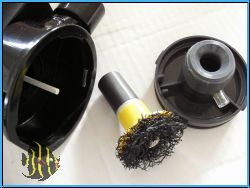
The Toledo Zoo Aquarium building closed October 1, 2012 for a $25.5 million renovation. The new Aquarium is scheduled to open in April, 2015. Because the formal planning for this project began as far back as 2005, the Aquarium staff had ample opportunity to research various types of aquarium life-support equipment.
Called “bench tests,” a series of semi-formal examinations were made of various filters, protein skimmers, and lights—to see what products would work best for our application. This testing was much easier to accomplish while the old Aquarium was still operational. Since these tests were performed in addition to our regular duties, and with a budget pretty close to zero, they were not necessarily comprehensive and were really designed to answer specific questions we had about particular products.
Protein skimmers
We discovered that one type of protein skimmer removed about 20% more waste than the brand we had been using—at half the cost! Because protein skimmers vary in the consistency of their output, we used a spectrophotometer to dilute one sample so that it matched the other—then just comparing the relative volumes told us which skimmer was working the best!
Lighting
You cannot always rely on the technical data supplied by salespeople and vendors. In one instance, we needed a light to supply ultraviolet rays for the health of the sea turtles planned for the exhibit. The salesperson assured us that the plastic cover over the light fixture would allow the UV light to pass. A quick 15-minute test with a UV meter borrowed from our reptile department showed that the plastic light cover actually blocked 98% of the UV light, so another product was selected.

We tested a variety of LED lights for over a year to determine if they could be used to replace existing lights, such as metal halide and fluorescent. In the end, after much discussion, we developed the following exhibit-lighting plan:
- LED spotlights—used to provide “glitter [shimmer] lines” in deep exhibits
- Variable LED lights for moon jellyfish interactive exhibit
- Metal halide and actinic day fluorescent lights over most large exhibits
- Metal halide and Solatube (natural lighting) over the live coral exhibits
- LED panel lights over smaller marine exhibit “Jewel” tanks
Filtration

A vendor supplied us with a large drum filter, which we tested on one of our exhibits for four months. We regularly checked water clarity using a turbidimeter and monitored the filter’s durability. Everything tested fine, so we plan to be the first Aquarium in the US to use this type of filter on its display aquariums.
Additional equipment and techniques
We were loaned a water pump called a “Hydrowizard,” designed for public aquariums by a European company, Panta Rhea (who also makes a smaller hobbyist model). Since few people had seen this pump at the time, we posted our report online for other aquarists to refer back to.
A contractor built an electrical device for us that takes the discharge from an electric eel and converts it to a signal that can be used to drive a speaker, a light system, or both. Since the device arrived while we still had an electric eel on exhibit, we wanted to fully test its operation (as shown in this video). Now, when the new Aquarium reopens, we can be assured that it will work as planned with our new eel!
We also worked on developing video and photographic techniques that will prove useful in the educational graphics in the new Aquarium. One interesting technique we plan to explore is time-lapse photography.
Photo Credit: Toledo Zoo




Great, this Zoo could get more interesting. Thanks for sharing this post to us. Good luck on your renovation!